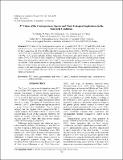| dc.contributor.author | S Sikolia, E Beck, JI Kinyamario, JC Onyango | |
| dc.date.accessioned | 2020-08-13T11:19:23Z | |
| dc.date.available | 2020-08-13T11:19:23Z | |
| dc.date.issued | 2008 | |
| dc.identifier.citation | 2 | en_US |
| dc.identifier.issn | 1811-9700 | |
| dc.identifier.uri | https://repository.maseno.ac.ke/handle/123456789/2080 | |
| dc.description.abstract | 13C values of the Centrospermeae species are presented. 69.5, 28.45, 1.25 and 0.8% of the total species are C3, C4, C3-C4 and CAM photosynthetic species. The δ13C values are species dependent. δ13C values for the C3 range from -21.16 to -30.28 while the C4 species vary from -10.60 to -16.55. An exceptional δ13C value of -32.28 is reported for Chenopodium capitatum. δ13C value for the CAM species vary from -16.00 to -18.50. C3-C4 species includes Mollugo nudicaulis, Portulacaria afra and Portulaca sp. nov. with δ13C values -25.89, -20.93 and -15.66, respectively. Temperature and precipitation are the dominant causal climatic factors that influence the distribution of the C3 and C4 species inversely and by extension the δ13C values along the altitude. Other climatic factors act synergistically. A difference in the δ13C values is a biochemical dual function of the Rubisco and suberized lamella anatomical structural organization. The occurrence of some C4 species in the unusual high altitude includes Melandrium nordiflorum and Silene abyssinica and may be due to the Pyruvate Phosphate Dikinase (PPDK) enzyme functional activity. Ecological significances of the δ13C values are discussed. | en_US |
| dc.publisher | Asian Network for scientific infomation | en_US |
| dc.subject | δ13C values;photosynthetic partway;C3 and C4 transition altitudinal zone;centrospermeal species; | en_US |
| dc.title | δ13 values of the Centrospermeae species and their ecological implications in the semi arid conditions | en_US |
| dc.type | Article | en_US |

